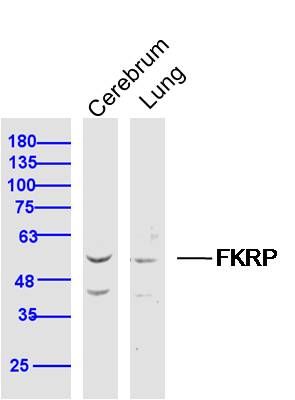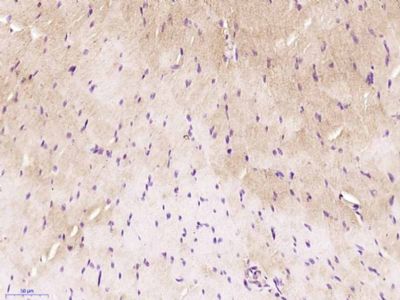产品中心
当前位置:首页>产品中心Anti-FKRP
货号: bs-16097R 基本售价: 1380.0 元 规格: 100ul
- 规格:100ul
- 价格:1380.00元
- 规格:200ul
- 价格:2200.00元
产品信息
- 产品编号
- bs-16097R
- 英文名称
- FKRP
- 中文名称
- FKRP蛋白抗体
- 别 名
- Fkrp; FKRP_HUMAN; FLJ12576; Fukutin related protein; Fukutin-related protein; LGMD2I; MDC1C; MGC2991.
- 规格价格
- 100ul/1380元购买 200ul/2200元购买 大包装/询价
- 说 明 书
- 100ul 200ul
- 研究领域
- 细胞生物 信号转导 转录调节因子
- 抗体来源
- Rabbit
- 克隆类型
- Polyclonal
- 交叉反应
- Human, Mouse, Rat, Dog, Pig, Rabbit,
- 产品应用
- WB=1:500-2000 ELISA=1:500-1000 IHC-P=1:400-800 IHC-F=1:400-800 ICC=1:100-500 IF=1:100-500 (石蜡切片需做抗原修复)
not yet tested in other applications.
optimal dilutions/concentrations should be determined by the end user.
- 分 子 量
- 55kDa
- 细胞定位
- 细胞浆 细胞膜 分泌型蛋白
- 性 状
- Lyophilized or Liquid
- 浓 度
- 1mg/ml
- 免 疫 原
- KLH conjugated synthetic peptide derived from human FKRP:1-100/495
- 亚 型
- IgG
- 纯化方法
- affinity purified by Protein A
- 储 存 液
- 0.01M TBS(pH7.4) with 1% BSA, 0.03% Proclin300 and 50% Glycerol.
- 保存条件
- Store at -20 °C for one year. Avoid repeated freeze/thaw cycles. The lyophilized antibody is stable at room temperature for at least one month and for greater than a year when kept at -20°C. When reconstituted in sterile pH 7.4 0.01M PBS or diluent of antibody the antibody is stable for at least two weeks at 2-4 °C.
- PubMed
- PubMed
- 产品介绍
- background:
This gene encodes a protein which is targeted to the medial Golgi apparatus and is necessary for posttranslational modification of dystroglycan. Mutations in this gene have been associated with congenital muscular dystrophy, mental retardation, and cerebellar cysts. Several alternatively spliced transcript variants of this gene have been described, but the full-length nature of some of these variants has not been determined. [provided by RefSeq, Oct 2008]
Function:
Could be a transferase involved in the modification of glycan moieties of alpha-dystroglycan (DAG1).
Subcellular Location:
Golgi apparatus. Secreted. Cell membrane > sarcolemma. Rough endoplasmic reticulum. According to some studies the N-terminal hydrophobic domain is cleaved after translocation to the Golgi apparatus and the protein is secreted. According to others the N-terminal hydrophobic domain is a transmembrane domain and the protein is a type II transmembrane type targeted to the Golgi apparatus by a non-cleavable signal anchor sequence. Localization at the cell membrane may require the presence of dystroglycan. At the Golgi apparatus localizes most likely at the cis-compartment. Detected in rough endoplasmic reticulum in myocytes. In general, mutants associated with severe clinical phenotypes are retained within the endoplasmic reticulum.
Tissue Specificity:
Expressed predominantly in skeletal muscle, placenta, and heart and relatively weakly in brain, lung, liver kidney and pancreas.
Post-translational modifications:
N-glycosylated.
DISEASE:
Defects in FKRP are the cause of muscular dystrophy-dystroglycanopathy congenital with brain and eye anomalies type A5 (MDDGA5) [MIM:613153]. MDDGA5 is an autosomal recessive disorder characterized by congenital muscular dystrophy associated with cobblestone lissencephaly and other brain anomalies, eye malformations, profound mental retardation, and death usually in the first years of life. Included diseases are the more severe Walker-Warburg syndrome and the slightly less severe muscle-eye-brain disease.Defects in FKRP are the cause of muscular dystrophy-dystroglycanopathy congenital with or without mental retardation type B5 (MDDGB5) [MIM:606612]. MDDGB5 is a congenital muscular dystrophy characterized by a severe phenotype with inability to walk, muscle hypertrophy, marked elevation of serum creatine kinase, a secondary deficiency of laminin alpha2, and a marked reduction in alpha-dystroglycan expression. Only a subset of MDDGB5 patients have brain involvements.
Defects in FKRP are the cause of muscular dystrophy-dystroglycanopathy limb-girdle type C5 (MDDGC5) [MIM:607155]; also known as limb-girdle muscular dystrophy type 2I. MDDGC5 is an autosomal recessive disorder with age of onset ranging from childhood to adult life, and variable severity. Clinical features include proximal muscle weakness, waddling gait, calf hypertrophy, cardiomyopathy and respiratory insufficiency. A reduction of alpha-dystroglycan and laminin alpha-2 expression can be observed on skeletal muscle biopsy from MDDGC5 patients.
Similarity:
Belongs to the licD transferase family.
SWISS:
Q9H9S5
Gene ID:
79147
Database links:Entrez Gene: 79147Human
Entrez Gene: 243853Mouse
Entrez Gene: 308390Rat
Omim: 606596Human
SwissProt: Q9H9S5Human
SwissProt: Q8CG64Mouse
Unigene: 515493Human
Unigene: 39703Mouse
Unigene: 474728Mouse
Unigene: 7371Rat
Important Note:
This product as supplied is intended for research use only, not for use in human, therapeutic or diagnostic applications.
- 产品图片
 Sample:
Sample:
Cerebrum (Mouse) Lysate at 40 ug
Lung (Mouse) Lysate at 40 ug
Primary: Anti-FKRP (bs-16097R) at 1/300 dilution
Secondary: IRDye800CW Goat Anti-Rabbit IgG at 1/20000 dilution
Predicted band size: 55 kD
Observed band size: 55 kD Paraformaldehyde-fixed, paraffin embedded (Rat skeletal muscle); Antigen retrieval by boiling in sodium citrate buffer (pH6.0) for 15min; Block endogenous peroxidase by 3% hydrogen peroxide for 20 minutes; Blocking buffer (normal goat serum) at 37°C for 30min; Antibody incubation with (FKRP) Polyclonal Antibody, Unconjugated (bs-16097R) at 1:400 overnight at 4°C, followed by operating according to SP Kit(Rabbit) (sp-0023) instructionsand DAB staining.
Paraformaldehyde-fixed, paraffin embedded (Rat skeletal muscle); Antigen retrieval by boiling in sodium citrate buffer (pH6.0) for 15min; Block endogenous peroxidase by 3% hydrogen peroxide for 20 minutes; Blocking buffer (normal goat serum) at 37°C for 30min; Antibody incubation with (FKRP) Polyclonal Antibody, Unconjugated (bs-16097R) at 1:400 overnight at 4°C, followed by operating according to SP Kit(Rabbit) (sp-0023) instructionsand DAB staining.

